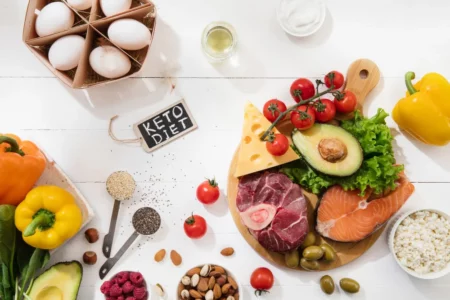 The ketogenic diet, or keto diet, has gained popularity for its potential to aid in weight loss by inducing a state of ketosis. Understanding the principles of the keto diet and implementing it wisely can contribute to effective and sustainable weight loss.
The ketogenic diet, or keto diet, has gained popularity for its potential to aid in weight loss by inducing a state of ketosis. Understanding the principles of the keto diet and implementing it wisely can contribute to effective and sustainable weight loss.
This diet can be an effective tool for weight loss when implemented mindfully. By understanding the principles, choosing nutrient-dense foods, and maintaining a balanced approach, you can navigate the keto diet successfully.
However, it’s essential to consult with a healthcare professional before starting any significant dietary changes to ensure they align with your individual health needs and goals.
Here’s a guide with subheadings to help you navigate the journey.
Understanding the Keto Diet
The keto diet is a low-carbohydrate, high-fat diet that encourages the body to enter ketosis, a metabolic state where it burns fat for fuel instead of carbohydrates. By significantly reducing carbohydrate intake and increasing fat consumption, the body shifts from using glucose to ketones for energy.
Emphasizing Low-Carb, High-Fat Foods
Focus on foods that are low in carbohydrates but high in healthy fats. Include sources of good fats such as avocados, olive oil, nuts, and fatty fish. Restrict your intake of grains, starchy vegetables, and sugary foods.
Incorporating Moderate Protein
While the keto diet is low in carbs, it includes a moderate amount of protein. Protein is essential for muscle maintenance and overall health. Choose lean protein sources like poultry, fish, and tofu to support your nutritional needs.
Transitioning into Ketosis
Achieving ketosis may take a few days to a week. During this period, your body adjusts to the low-carb intake and begins producing ketones. Be patient and stay hydrated to support the transition.
Monitoring Carb Intake
Keep a close eye on your daily carbohydrate intake, aiming for around 20-50 grams of net carbs per day. Net carbs are calculated by subtracting fiber from total carbs. This restriction is crucial for maintaining ketosis.
Staying Hydrated
Drinking enough water is essential to the keto diet. Adequate hydration supports digestion, helps prevent constipation, and can alleviate symptoms like the “keto flu” during the initial stages.
Planning Balanced Meals
Create well-balanced meals that incorporate a variety of foods. Include non-starchy vegetables, moderate protein, and healthy fats to ensure you receive a spectrum of nutrients.
Monitoring Progress and Adjusting
Regularly assess your progress and adjust your diet as needed. Pay attention to how your body responds and make modifications to optimize your weight loss journey.
Picture Credit: Freepik
